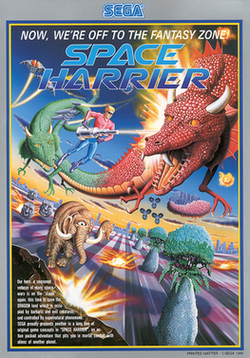Space Harrier
| Space Harrier | |
|---|---|

1986 European arcade flyer, featuring title protagonist Harrier battling several enemies that appear in the game.
|
|
| Developer(s) |
Sega Enterprises Sega AM4 Dempa Elite Systems Rutubo Games |
| Publisher(s) | |
| Distributor(s) | |
| Designer(s) | Yu Suzuki |
| Composer(s) | Hiroshi Kawaguchi |
| Platform(s) | |
| Release date(s) |
December 1985
|
| Genre(s) | Rail shooter, third-person shooter |
| Mode(s) | Single player |
| Cabinet | Standard and sit-down |
| Arcade system | Sega Space Harrier Hardware |
| CPU | 2x 68000 (@ 10 MHz) Sound CPU: Z80 (@ 4 MHz) |
| Sound |
YM2203 (@ 4 MHz) Sega PCM (@ 31.25 kHz) |
| Display |
Raster, standard resolution, horizontal orientation, 6144 out of 98,304 colors |
| Aggregate scores | |
|---|---|
| Aggregator | Score |
| GameRankings | 77.25% (3DS) |
| Metacritic | 70 (3DS) |
| Review scores | |
| Publication | Score |
| AllGame | 4.5/5 (32X) 2.5/5 (PC) 4.5/5 (SMS) 3/5 (TG16) 3/5 (Wii) |
| CVG | 35/40 (PC) 78% (SMS) 89% (TG16) 82% (Amiga) |
| Crash | 77% (PC) |
| GamePro | 4/5 (32X) |
| GameSpy | 9/10 (SMS) |
| IGN | 4.5/10 (Wii) |
| Sinclair User | 5/5 (PC) |
| Your Sinclair | 9/10 (PC) |
Space Harrier (Japanese: スペースハリアー Hepburn: Supēsu Hariā?) is an arcade video game developed and released by Sega Enterprises in December 1985. Originally conceived as a realistic military-themed game played in the third-person perspective and featuring a player-controlled fighter jet, technical and memory restrictions at the time resulted in Sega developer Yu Suzuki redesigning it to fit a fantasy setting centered around a jet-propelled human character. Critically praised for its innovative graphics and gameplay, Space Harrier is often ranked among Suzuki's best works and considered the first successful entry in the third-person and rail shooter game genres. It has made several crossover appearances in other Sega titles and inspired clone games by various developers, while PlatinumGames director Hideki Kamiya cited it as an inspiration for his entering the video game industry.
Space Harrier has been ported to over twenty different home computer and gaming platforms, either by Sega or outside developers such as Dempa in Japan and Elite Systems in North America and Europe. Two home-system sequels followed in Space Harrier 3-D (1988) and Space Harrier II (1988), as well as an arcade spinoff, Planet Harriers, in 2000. A polygon-based remake of the original game was released by Sega for the PlayStation 2 as part of their Sega Ages series in 2003.
...
Wikipedia
